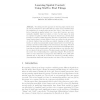Free Online Productivity Tools
i2Speak
i2Symbol
i2OCR
iTex2Img
iWeb2Print
iWeb2Shot
i2Type
iPdf2Split
iPdf2Merge
i2Bopomofo
i2Arabic
i2Style
i2Image
i2PDF
iLatex2Rtf
Sci2ools
ECCV
2008
Springer
2008
Springer
Learning Spatial Context: Using Stuff to Find Things
The sliding window approach of detecting rigid objects (such as cars) is predicated on the belief that the object can be identified from the appearance in a small region around the object. Other types of objects of amorphous spatial extent (e.g., trees, sky), however, are more naturally classified based on texture or color. In this paper, we seek to combine recognition of these two types of objects into a system that leverages "context" toward improving detection. In particular, we cluster image regions based on their ability to serve as context for the detection of objects. Rather than providing an explicit training set with region labels, our method automatically groups regions based on both their appearance and their relationships to the detections in the image. We show that our things and stuff (TAS) context model produces meaningful clusters that are readily interpretable, and helps improve our detection ability over state-of-the-art detectors. We also present a method f...
Computer Vision | Detection Ability | ECCV 2008 | Object Detection | Overhead Car Detection | State-of-the-art Detectors | VOC 2005/2006 Datasets |
| Added | 15 Oct 2009 |
| Updated | 15 Oct 2009 |
| Type | Conference |
| Year | 2008 |
| Where | ECCV |
| Authors | Geremy Heitz, Daphne Koller |
Comments (0)

